Funding will shed light on "dark data," and integrate organismal, vocal, fossil, and ecological information.-
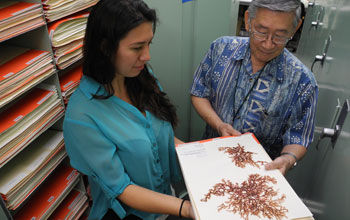
|
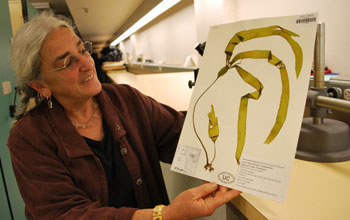
| Curator Kathy Ann Miller looks at seaweed collected along the coast of Washington. Credit: Sheraz Sadiq, KQED Science |
| Download the high-resolution JPG version of the image. (3.5 MB) |
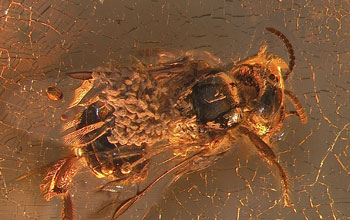
| NSF's ADBC Program will foster advances in digitizing biological specimen collections. Credit: Santiago Ramirez, Museum of Comparative Zoology, Harvard University |
| Download the high-resolution JPG version of the image. (1.8 MB) |
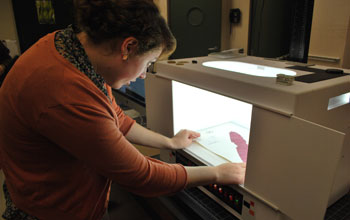
| Researcher Clare Loughran takes a digital photo of a red seaweed using a special light box. Credit: Sheraz Sadiq, KQED Science |
| Download the high-resolution JPG version of the image. (4.8 MB) |
Over centuries of discovery, the diversity of life on Earth has been documented in numerous ways.
Records of that biodiversity are, however, often obscured in varied and distinct natural history collections, making accessing the information a difficult task.
The National Science Foundation (NSF), through its Advancing Digitization of Biodiversity Collections (ADBC) Program, is responding to the need for greater accessibility of biodiversity collections data by awarding major new grants.
The funding will expand the scope of the national resource of digital data documenting existing biodiversity collections.
The awards are part of the National Resource for Digitization of Biological Collections; all data resulting from the awards will be available through the national resource.
Biological diversity is critical to the future of planet Earth, say researchers. Incomplete information on species, their distributions and environmental and biological changes over time make it difficult, however, to assess the status of and changes in biodiversity.
Much of the relevant information exists in research collections, scientists say, but the majority isn't integrated and isn't readily available online.
It's "dark data"--inaccessible to most biologists, policy-makers and the general public.
"The ADBC program continues to grow in the breadth of its collections, including fossils, and in the depth of additional information about each specimen," says John Wingfield, NSF assistant director for Biological Sciences.
"The collections being digitized are unprecedented in their worth to research and education and hold huge potential for future development and integration with other biological data from genomes to phenomes," says Wingfield.
"With the diversity of information digitized, these projects are addressing issues of interoperability, access and analysis--'big data.' The benefits will be felt for many generations to come."
The program will result in more efficient and innovative ways of providing access to information in biological and paleontological research collections.
It will also help speed up the process of integrating diverse information on the genetic, ecological, organismal (including vocalizations), molecular biology and evolutionary history of specimens in collections.
"During the past 200 or more years, an abundance of fossil collections that are scientifically documented, biotically diverse and geologically distributed in time and space has been accessioned into non-federal museums across the U.S.," says Wendy Harrison, director of NSF's Division of Earth Sciences.
Such collections, she says, are the building blocks for paleontology, stratigraphy, paleogeography, paleoceanography and paleoecology.
"These scientific 'treasures' are of great importance to our search and production of fossil fuels and minerals, as well as to unraveling the history of the Earth and life itself," says Harrison.
"Having the vital statistics and visuals of these collections available on the Web will place these sciences on a new level of integration and understanding."
Standardized digital photos of specimens will be linked with, for example, sound recordings, pathogens found on the specimens, stratigraphic information for fossils, environmental variables at the collecting localities and electron micrographs.
"Insects, for example, have a long geologic history, providing a deep-time record of ecological and evolutionary responses to environmental changes," says H. Richard Lane, program director in NSF's Division of Earth Sciences.
"With current models of future climate change and the important role insects play in human society, the ability to access modern and fossil archived data to make predictions about future insect populations becomes urgent."
Training for future researchers on collections techniques, informatics technology and data integration is part of ADBC efforts.
The awards provide graduate and undergraduate training opportunities and outreach to K-12 educators, students and non-scientists.
Each of the three Thematic Collections Networks (TCN) focuses on "grand challenge," or major scientific, questions in biodiversity, and offers multiple research opportunities as data become widely available.
"The new fossil insect TCN, for example, promises to accelerate our understanding of the insect world--past, present and future," says Lane.
The awards include 65 institutions in 29 states and one territory.
In addition, five Partners to Existing Networks (PEN) were funded.
These efforts allow institutions that were not fully ready to participate in a TCN to add to their collections and fill in gaps.
Two PEN awards have been made that will increase the coverage of the Paleoniches TCN. The TCN is focused on critical specimens needed to identify organisms and environments from ages and localities not previously included.
A third PEN will expand the Southwest Arthropod Network, which also includes field guides for the Navajo reservation area; a fourth PEN will add central Midwest specimens to the InvertNet TCN; and a fifth will add two historically important collections to the lichen and bryophyte TCN.
2013 NSF ADBC Awards
Title: (TCN) Fossil Insect Collaborative: A Deep-Time Approach to Studying Diversification and Response to Environmental Change
PI (Principal Investigator):
Collaboratoring Award PIs: Sam Heads, University of Illinois Urbana-Champaign; David Grimaldi, American Museum of Natural History; Alton Dooley, Virginia Museum of Natural History; Michael Engle, University of Kansas; Brian Farrell, Harvard University; Susan Butts, Yale University.
Title: (TCN) Developing a Centralized Digital Archive of Vouchered Animal Communication Signals
PI (Principal Investigator):
Collaboratoring Award PIs: Rafe Brown, University of Kansas; David Kavanaugh, California Academy of Sciences; Travis LaDuc, University of Texas at Austin; Daniel Lane, Louisiana State University & Agricultural and Mechanical College.
Title: (TCN) The Macroalgal Herbarium Consortium: Accessing 150 Years of Specimen Data to Understand Changes in the Marine/Aquatic Environment
PI (Principal Investigator):
Collaboratoring Award PIs: Christopher Dick, University of Michigan, Ann Arbor; Brent Mishler, University of California Berkeley; David Giblin, University of Washington; Alan Weakley, University of North Carolina at Chapel Hill; Kenneth Karol, New York Botanical Garden.
The five PEN awards are:
Title: (PEN) Targeted Digitization to Expand and Enhance the PALEONICHES TCN
Title: (PEN) Increasing the Robustness of the Ordovician and Pennsylvanian Dataset of PALEONICHES-TCN
Title: (PEN) Facilitating a Shared Image Library and Occurrence Database for Ants of the Southwest as Part of the SCAN TCN
Title: (PEN) Digitizing the University of Iowa Museum of Natural History's Historic Invertebrate Collections through the InvertNet TCN
Title: (PEN) Digitization of two Important Medium-sized Collections to Join the North American Bryophytes and Lichens TCN
-NSF-
Media Contacts Cheryl Dybas, NSF (703) 292-7734
Related WebsitesNSF News: NSF Awards Second Round of Grants to Advance Digitization of Biological Collections: http://www.nsf.gov/news/news_summ.jsp?cntn_id=124031
NSF News: NSF Awards First Round of Grants to Advance Digitization of Biological Collections: http://www.nsf.gov/news/news_summ.jsp?cntn_id=121015&org=NSF&from=news
NSF News: NSF Awards First Round of Grants to Advance Digitization of Biological Collections: http://www.nsf.gov/news/news_summ.jsp?cntn_id=121015&org=NSF&from=news
The National Science Foundation (NSF) is an independent federal agency that supports fundamental research and education across all fields of science and engineering. In fiscal year (FY) 2012, its budget was $7.0 billion. NSF funds reach all 50 states through grants to nearly 2,000 colleges, universities and other institutions. Each year, NSF receives about 50,000 competitive requests for funding, and makes about 11,500 new funding awards. NSF also awards about $593 million in professional and service contracts yearly.
Useful NSF Web Sites:
NSF Home Page:
NSF Home Page:
http://www.nsf.gov
NSF News:
NSF News:
http://www.nsf.gov/news/
For the News Media:
For the News Media:
http://www.nsf.gov/news/newsroom.jsp
Science and Engineering Statistics:
Science and Engineering Statistics:
http://www.nsf.gov/statistics/
Awards Searches:
Awards Searches:
The National Science Foundation (NSF).
Guillermo Gonzalo Sánchez Achutegui
ayabaca@gmail.com
ayabaca@hotmail.com
ayabaca@yahoo.com
Inscríbete en el Foro del blog y participa : A Vuelo De Un Quinde - El Foro!

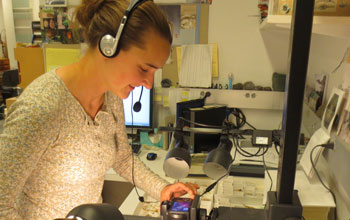
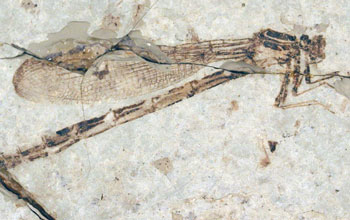
No hay comentarios:
Publicar un comentario